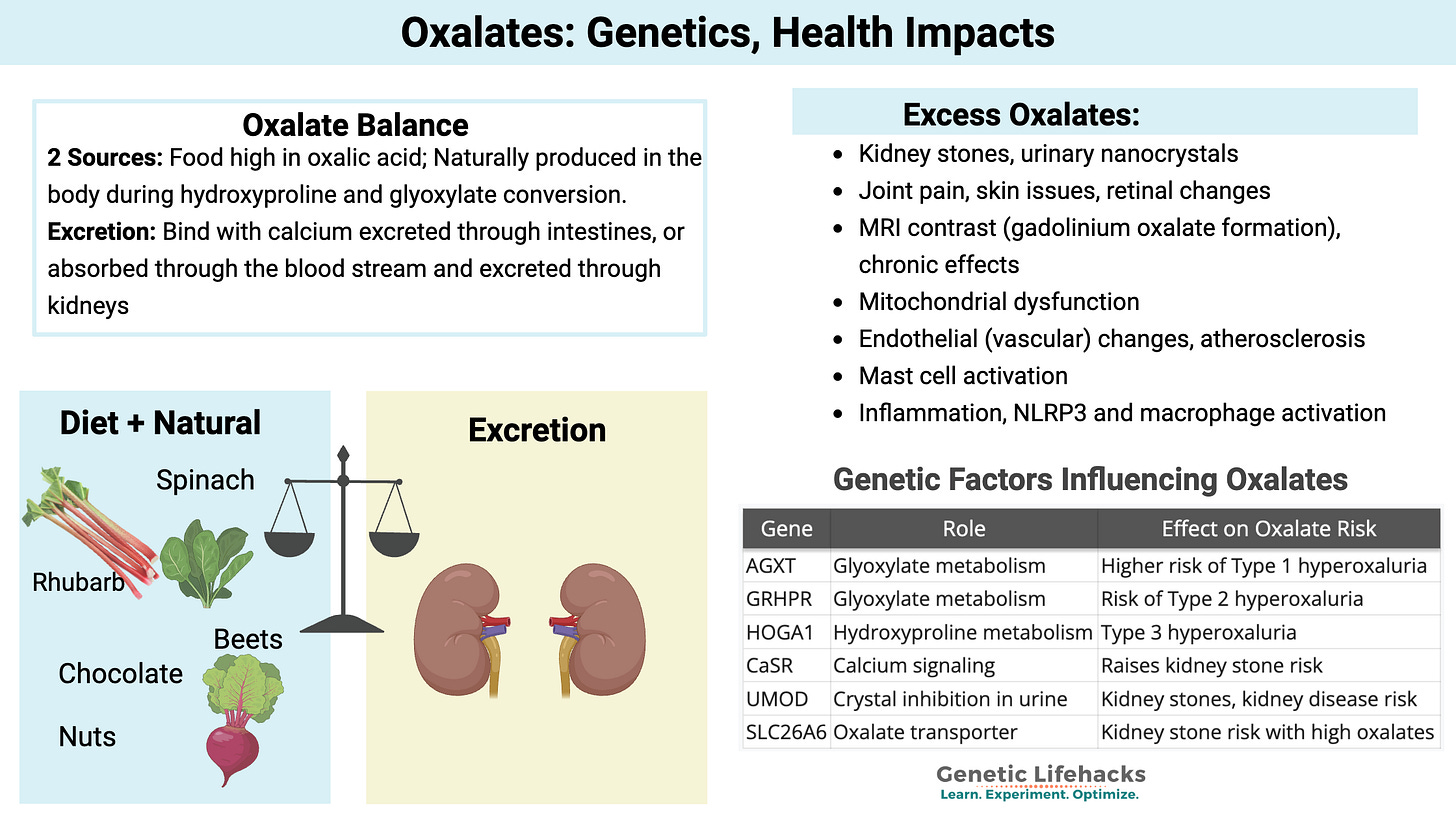Exploring connections:
I've significantly expanded my article on oxalates, incorporating a bunch of new research studies and linking them together with related articles on the site.
Oxalates and health connections:
Oxalates (oxalic acid) are naturally found in foods such as spinach, dark chocolate, beets, and rhubarb. Our bodies also produce oxalate as a byproduct of metabolism. Generally, about half of the oxalate in the body comes from diet, with the other half due to endogenous production.
Oxalates are primarily eliminated through the kidneys, with some excreted back into the intestines.
The first problem that comes to most people's minds with oxalates is the formation of oxalate crystals, which make up kidney stones -- something we all want to avoid.
However, oxalate crystals can also accumulate in your joints, soft tissue, blood vessels, the eye, and even the brain.
This can lead to joint inflammation (oxalate arthritis), pain, muscle cramps, skin rash, vascular issues, and fatigue.
Of course, these symptoms have multiple possible causes.
How can you know if it's due to high oxalates?
Identifying Oxalate Issues:
Here are a few things to look at in determining if oxalates are even something that should be on your radar:
Genetic factors: Check your genetic data to see if you have any variants or rare mutations in the AGXT or GRHPR genes, which increase endogenous oxalate production. Genetic Lifehacks active members can see their genetic data in the oxalates article here.
Malabsorption issues: Another cause of high oxalate levels is intestinal problems that cause malabsorption issues, especially fat malabsorption. These could be due to inflammatory bowel diseases, pancreatitis, pancreatic enzyme insufficiency, celiac, or even bariatric surgery. Kidney disease can also decrease the excretion of oxalate.
Diet: Consumint a high amount of oxalate in foods -- green spinach smoothies or eating a lot of beets -- can also tip the balance toward high oxalate levels. This is especially a concern if the high oxalate foods are often consumed without any dietary calcium.
MRI contrast: A final connection here is that a recent study showed that gadolinium from MRI contrast agents can precipitate with higher oxalate levels to form gadolinium oxalate nanoparticles.
There isn't an easy one-size-fits-all answer on whether you are likely to need to reduce your dietary oxalate consumption. Even if your joint inflammation relates to oxalate crystals, genetics - such as an NLRP3 variant - may influence your body’s inflammatory response to oxalates.
New: Member support knowledge base:
To improve customer support, I've put together a help site and am working on a new method for answering member questions. I've learned recently that some of my replies to members are ending up in spam, so I'm working on solutions to resolve it.
If you have a question that isn't covered in the FAQs, or just have a suggestion for improvement, please reach out. Genetic Lifehacks is member-supported, which means that I am committed to continually updating and improving it.
Stay curious!
Debbie
Oxalates: What Your Genes and Diet Say About Oxalate Health Issues
Key takeaways:
~ Many healthy foods contain oxalates, but dietary intake must be balanced with the metabolism and excretion of oxalates.
~ Genetic variants can disrupt the balance of oxalate excretion from the body, leading to the formation of kidney stones or oxalate crystals.
~ Genes also impact the biosynthesis of oxalates in the body.
~ Oxalate crystals can accumulate in the joints, skin, vasculature, and even the brain – leading to inflammation, mitochondrial dysfunction, and cell damage.
Read the rest of the article here
Longevity Lifehacks:
Longevity Supplements: How many capsules are you swallowing each day?
What I've been reading:
1. SARS-CoV-2 induces Alzheimer’s disease–related amyloid-β pathology in ex vivo human retinal explants and retinal organoids
This is an interesting new study on how SARS-CoV-2 may cause amyloid-beta formation. In it, the researchers found "pharmacological inhibition of neuropilin-1 resulted in reduced amyloid-β deposition".
Neuropilin-1 acts as a receptor for SARS-CoV-2. https://geneticlifehacks.com/neuropilins-healthy-blood-vessels-covid-brain/
2. Gabapentin and the increased risk of dementia
A large medical records study shows that people who were prescribed gabapentin six or more times for pain are at a 29% increased relative risk of dementia and 85% increased relative risk of mild cognitive impairment.
Genetic Lifehacks back pain article






I've been on a low oxalate diet for just over a year, and today I feel better than I ever have. My energy levels are good, my brain fog has cleared, I've been able to stop my supplemental thyroid hormones for hypothyroidism (which I've also treated with DMSO) and I'm experiencing many other benefits. It has not been easy to give up the high oxalate foods I love. But I've found that there are many things I can eat and enjoy that don't add to my oxalate load. We just have to be flexible and try new things. I encourage anyone who believes they might have an issue with oxalates to study the issue and get good advice on how to begin to implement the low oxalate diet. The effort paid off big for me, and it could do the same for others.